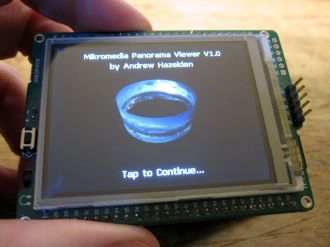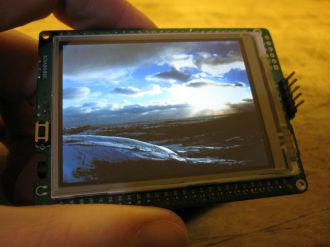
We strongly encourage users to use Package manager for sharing their code on Libstock website, because it boosts your efficiency and leaves the end user with no room for error. [more info]

Rating:
Author: Andrew Hazelden
Last Updated: 2013-01-01
Package Version: 1.0.0.0
Category: Gaming and Fun
Downloaded: 844 times
Not followed.
License: MIT license
The Mikromedia Panorama example displays a 1920x240px cylindrical panorama on the Mikromedia dsPIC33 or PIC32 screen. The panorama example was created to show how the VisualTFT resource collection feature can be used to load sliced images. The code was written using VisualTFT and MikroC Pro.
Do you want to subscribe in order to receive notifications regarding "Mikromedia Panorama Viewer" changes.
Do you want to unsubscribe in order to stop receiving notifications regarding "Mikromedia Panorama Viewer" changes.
Do you want to report abuse regarding "Mikromedia Panorama Viewer".
| DOWNLOAD LINK | RELATED COMPILER | CONTAINS |
|---|---|---|
| 1357094064_mikromedia_panor_mikroc_dspic.zip [3.70MB] | mikroC PRO for dsPIC30/33 & PIC24 |
|
| 1357094334_mikromedia_panor_mikroc_pic32.zip [3.72MB] | mikroC PRO for PIC32 |
|

This is the opening title screen for the MMB pano Hex firmware.
View full image
With the Panorama Viewer firmware you can explore cylindrical panoramas using the Mikromedia's color touch screen display.
View full image
1. Install Firmware: Flash the Pano_DSPIC33.hex firmware file to your Mikromedia dsPIC33 board. Flash the Pano_PIC32.hex firmware file to your Mikromedia PIC32 board.
2. Install resource file: Copy the resource file Pano_res.RES to the root folder of your Mikromedia board's MicroSD memory card.
3. Enjoy the fun of an interactive panorama on your Mikromedia dsPIC33 or PIC32 screen.
Mikromedia for dsPIC33 (dsPIC33FJ256GP710A)
http://www.mikroe.com/mikromedia/dspic33/
or
Mikromedia for PIC32 (PIC32MX460F512L MCU)
http://www.mikroe.com/mikromedia/pic32/
When creating an image sequence for use with VisualTFT use the file naming convention of image###.bmp
eg. image001.bmp to image192.bmp
The images should be loaded in Visual TFT using the resource collection icon in the toolbar. Save the images to an external VisualTFT resource file.
The Pano_frames.h header file creates the image address array named "PANO_FRAMES" that holds the names of each of the slices in the panorama. When I created the Pano_frames.h array I looked in the file Pano_resources.h to find out the names that VisualTFT / MikroC used for each BMP frame in the panorama.
When VisualTFT saves an external image resource to the .res file it writes the external image pointer address for the image pano001.bmp in the resource.h file as:
#define pano001_bmp 0x0000738A
If you are creating a array of VisualTFT .res external image references keep in mind that C code arrays start at index position 0. This also means you have to be careful of off by one errors when looping the panorama.
eg. The first frame in the array begins at PANO_FRAMES[0] and image number 384 is located at PANO_FRAMES[383].
To change the panorama slice size you need to edit the lines:
// Sets the width in pixels of a panorama slice
#define SLICE_WIDTH 2
and
// Sets how many slices are visible onscreen at once
#define VISIBLE_SLICES 160